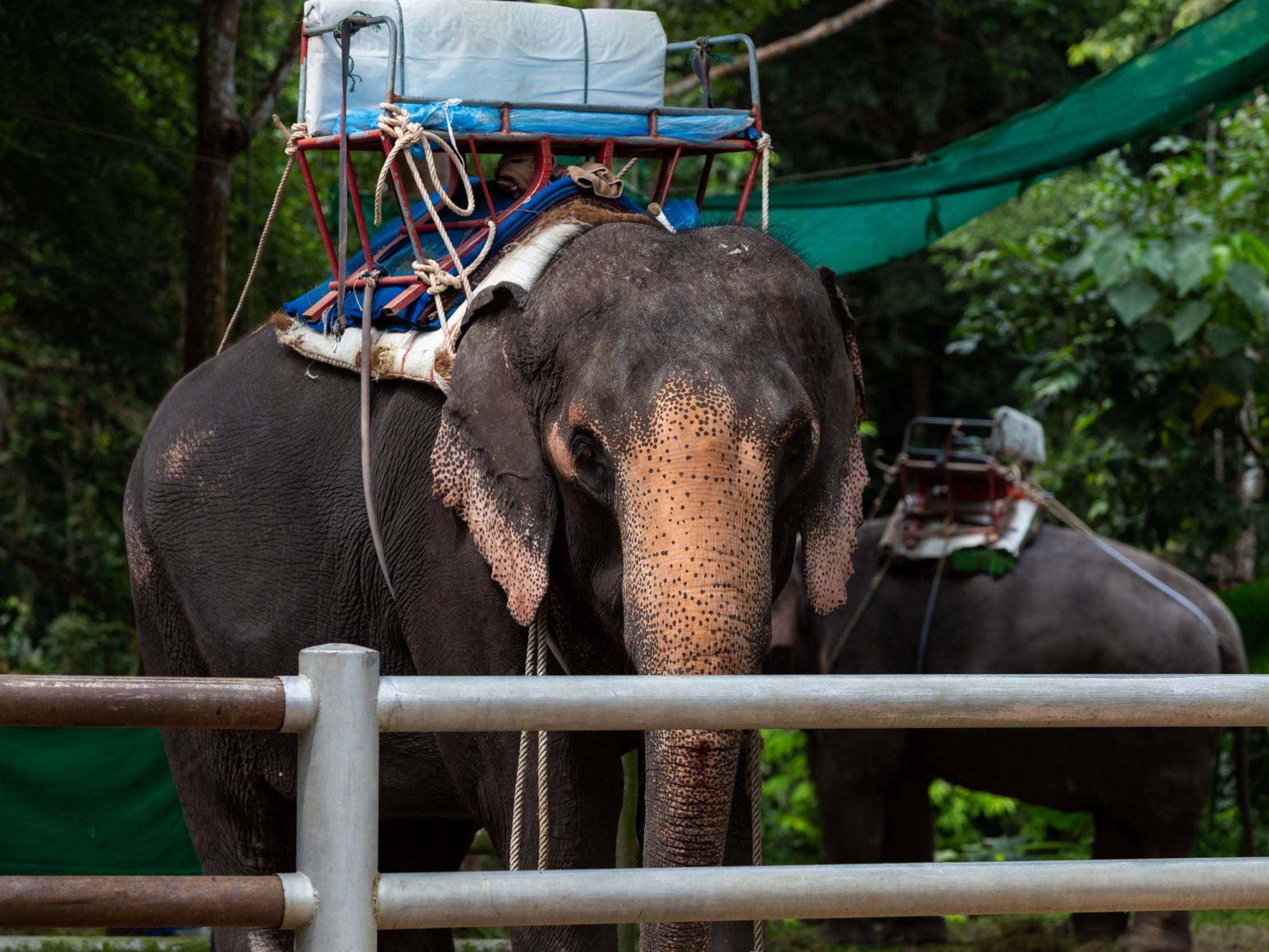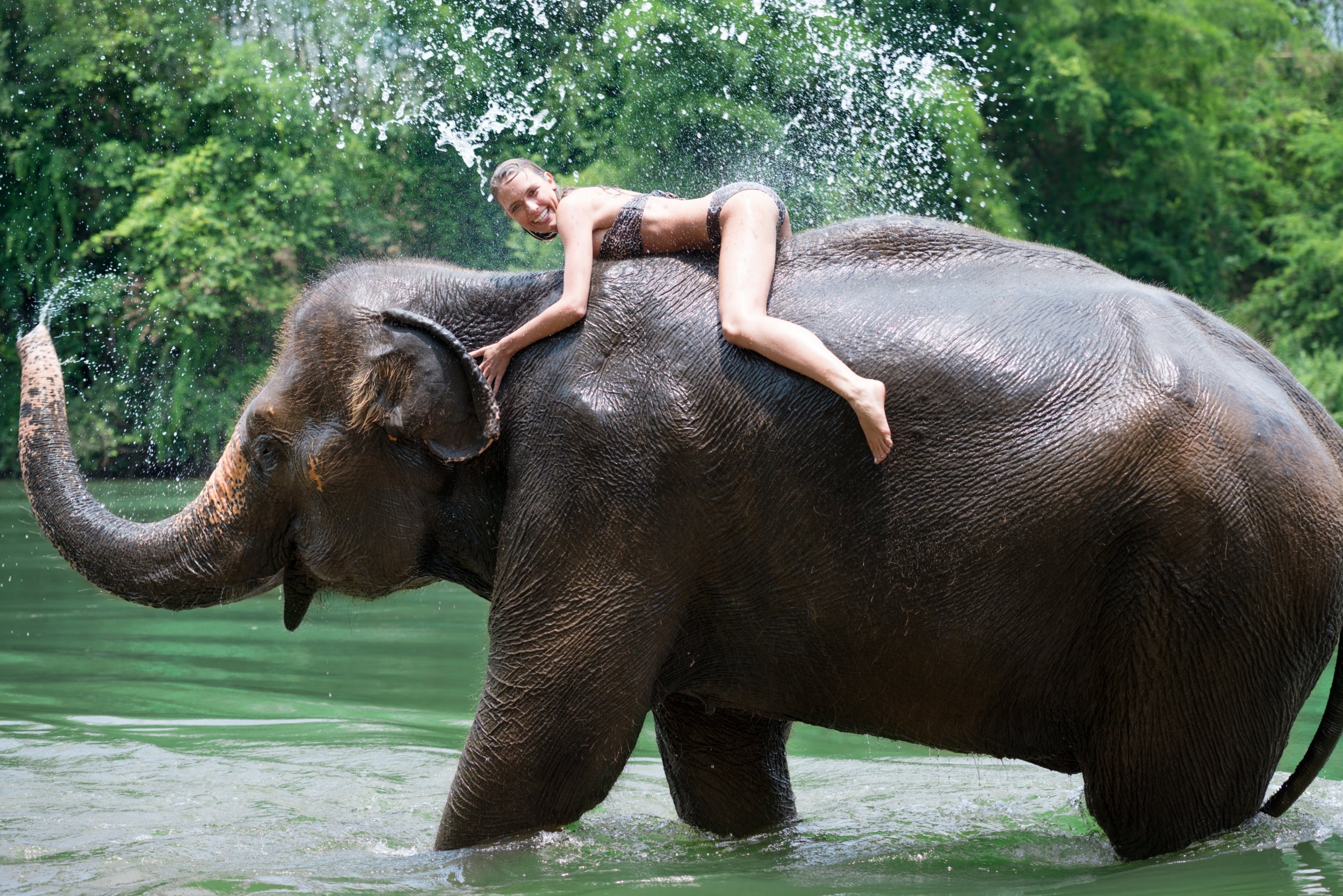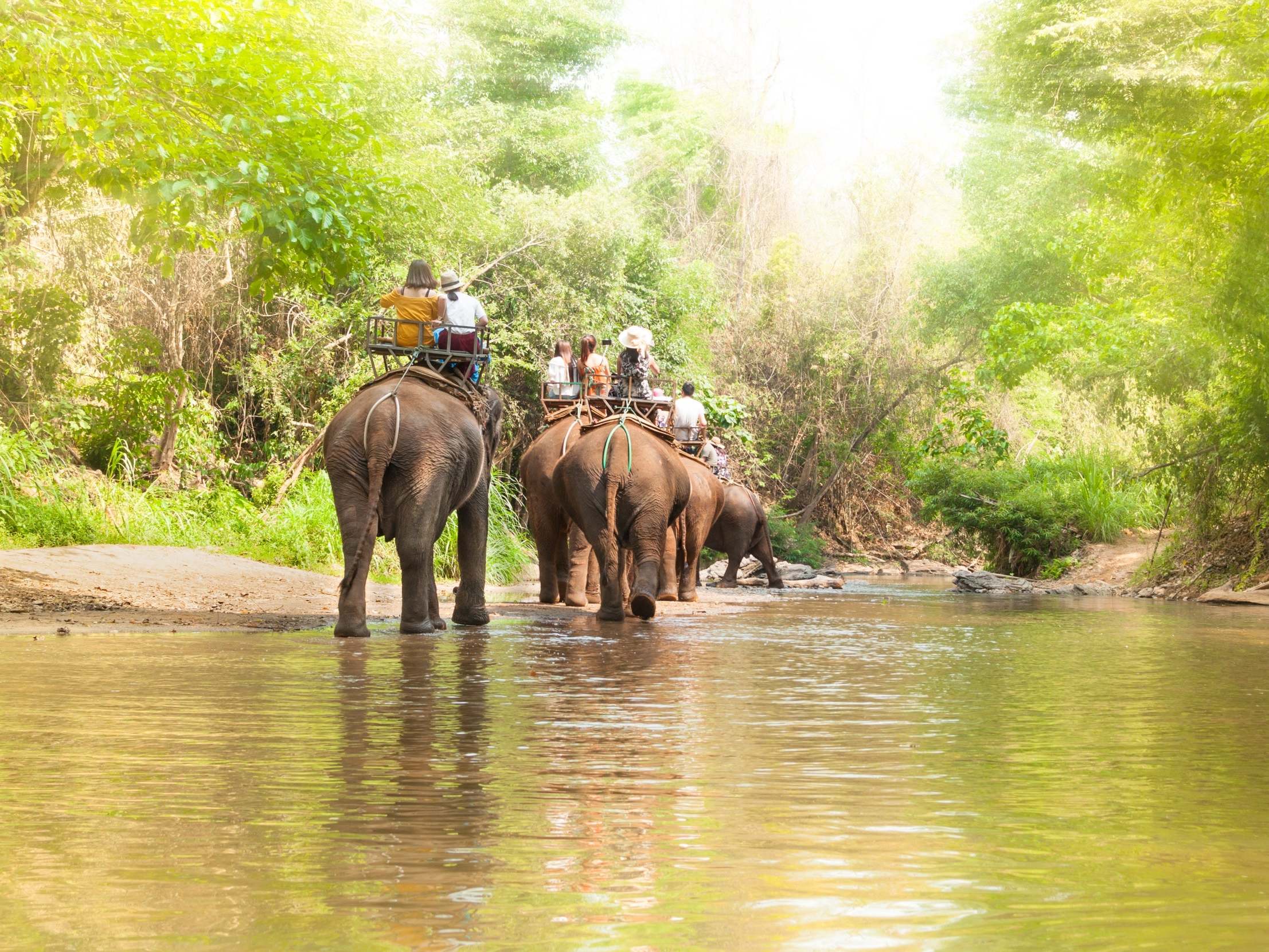Elephant rides in Thailand: Just tourism or abuse?
Riding an elephant in Thailand is at the top of most people’s bucket list. But is it wrong? Donald Frazier writes

Your support helps us to tell the story
From reproductive rights to climate change to Big Tech, The Independent is on the ground when the story is developing. Whether it's investigating the financials of Elon Musk's pro-Trump PAC or producing our latest documentary, 'The A Word', which shines a light on the American women fighting for reproductive rights, we know how important it is to parse out the facts from the messaging.
At such a critical moment in US history, we need reporters on the ground. Your donation allows us to keep sending journalists to speak to both sides of the story.
The Independent is trusted by Americans across the entire political spectrum. And unlike many other quality news outlets, we choose not to lock Americans out of our reporting and analysis with paywalls. We believe quality journalism should be available to everyone, paid for by those who can afford it.
Your support makes all the difference.More than half of Thailand’s 7,000 elephants live in captivity. It’s been that way ever since 1989, when the country suspended almost all of the commercial logging that had employed them for generations. Jobless elephants, often with their keepers, ended up on the streets, wandering across farmlands or taking shelter in dangerous spots like highway underpasses.
Today, almost all of the captive animals work to entertain tourists, often in remote clearings, for small-scale operations with no more than 15 elephants, similar to roadside farms in the US that have emerged as tourist destinations. Sometimes visitors simply wander among and feed the elephants. But many of the so-called elephant camps let visitors bathe with them and ride them. And larger, more touristy sites present displays that range from a few circus-style tricks to Vegas-like pageants with costumes, scripted narratives and light shows.
Travellers who want to see, encounter and maybe play with the region’s elephants face an agonising question: how can they know if they are supporting the abuse of these emblematic animals?
Is elephant tourism abuse?
Several global organisations say that elephant tourism is inherently wrong, and should be phased out. “Animals do not exist for our entertainment,” says Delcianna Winders, a lawyer for People for the Ethical Treatment of Animals (Peta), which was instrumental in the long-lasting, high-profile campaign that removed elephant acts from US circuses in 2016.
Jan Schmidt-Burbach, senior wildlife and veterinary adviser for World Animal Protection, says that any elephant tourism, no matter how well-intentioned, drives a market where abuse is inevitable. The group insists all elephants need to be on protected reservations, with minimal contact, often limited to observation, sometimes from afar.
But Janine Brown, chief elephant scientist for the Smithsonian Institution’s Centre for Species Survival and a member of the Asian Captive Elephant Working Group, a consortium of the region’s scientists, veterinarians, conservationists and other experts, says creating reserves for all the country’s elephants is not possible. “It’s impossible to give a specific number of square acres per elephant,” she says. “But whatever it is, it’s more than today’s Thailand can offer.”

Besides, it’s expensive to keep an elephant. Food can cost up to $38 (£30) per day, says John Roberts, head of the Golden Triangle Asian Elephant Foundation and a key mover of Thailand’s elephant-friendly tourism initiatives. Other expenses push the total to around $56 in a country where a family of four can eat for as little as $18 per day. Nobody has proposed another way to fund the upkeep of so many unemployed elephants and support thousands of keepers.
How can you know how a camp treats its elephants?
A new understanding about how to handle Asian elephants, as well as a global craving for ethical and sustainable travel, pressure from the rest of the world travel industry and the glare of negative publicity, have driven improvement in the lives of Thailand’s elephants.
It’s impossible to give a specific number of square acres per elephant but whatever it is, it’s more than today’s Thailand can offer
But tourists never really know what happens once the last bus heads back down the dusty road to Chiang Mai, the centre of this trade. In a chaotic, competitive business with little regulation and lots of unreliable information, elephant-seekers have had few ways to find out whether a camp operator is abusing the animals once the tours depart.
In fact, some camps have found a clever workaround to the ban on riding imposed by some western travel agencies. They will host one group in the morning that allows no riding, and another group in the afternoon that wants riding. After the first bus leaves and before the next one arrives, the camp will simply change its name.

Travel agencies do not provide much guidance. An aggressive publicity campaign, especially in Europe, has convinced many of them to boycott elephant camps that offer experiences like riding and bathing. Even top US agencies don’t have either the scientific expertise or the ability to operate in Thailand’s countryside that it takes to tell a kindly camp from an abusive one.
But an ambitious new audit programme, a first for southeast Asia’s commercial elephant tourist sites, may have an answer. To gain certification through the new Captive Elephant Welfare Initiative, camp operators must submit to detailed, regular inspections on everything from the elephants’ diet and medical care to the training and salaries for mahouts, the local caretakers who often bond with an elephant for much of its life. It bars rough handling and circus-like attractions such as the shows where elephants ride giant tricycles or handle fireworks.
The new initiative was created by scientists belonging to the Asian Captive Elephant Working Group. A well-managed camp, the working group members say, is far less likely to run short of cash and overwork its elephants.
Who is grading the camps?
A group known as Travelife for Tour Operators and Travel Agencies, an Amsterdam-based ratings provider to travel agents in Europe, Australia and many other countries, is responsible for evaluating the camps and certifying in-country tour operators, creating financial incentives for camps that treat elephants well.
Travelife has carved out a special niche in global travel for tourists who want to limit their impact on the environment and the places they visit, including the people and wildlife. According to David Fennell, a professor at Brock University, in Ontario, Canada, credible ratings companies like Travelife have become an “absolutely critical resource” to the fast-emerging “green” segment of the travel industry. “There’s a great deal of disinformation and ‘green-washing’ on the internet. And Travelife has plenty of endorsements from solid, reputable players,” Fennell says.

Travelife dispatches expert field inspectors to check the sustainability practices of companies in green tourism, from hotels to tour buses. It’s especially sensitive to matters eco-minded tourists started noticing recently, such as recycling, food waste and the treatment of workers, cultural sites and animals.
In Thailand, it has audited 20 elephant camps for compliance so far. It has also trained and certified 10 tour operators, the in-country “destination managers” who assemble the packages that travel agencies sell to tourists. These companies are the centrepiece of the programme: they make sure the camps treat elephants well and train workers, from business managers to stable hands, on best practices from the Captive Elephant Initiative. In return, they promise to send business only to these camps. Right now these camps include some of the largest and best known, such as Patara Elephant Farm and Maesa Elephant Camp.
Travelife’s programme currently applies only to Thailand, the most popular destination for elephant tourism.
According to Niels Steeman, group marketing manager for Asian Trails, a leading tour operator and a supporter of the initiative: “This project will channel business through the supply chain to the camps that measure up to the new standards, and this will induce other camps to improve as well.

“This set of relationships gives it to them, and financially rewards the camps that take part,” he says.
Buffalo Tours, one of the 10 operators working with Travelife in Thailand, has sent more than 4,000 tourists to complying elephant camps so far this year, according to its marketing manager, Ewan Cluckie, and others report similar results. That number could grow as bigger companies like Royal Caribbean Cruise Line add Travelife-approved elephant tours as shore excursions.
What do the guidelines say?
Much of the 109-page checklist is devoted to basic health, based on scientists’ long study of working elephants’ proper diet, exercise and activity. For example, they need strenuous work such as rugged jungle treks in order to properly digest. Few of the people who run elephant camps have been professionally trained in how to care for them and have begun to rely on experts, often from the national university’s elephant centre.
The guidelines include specific rules for riding elephants, restraining them with leg chains for limited periods of time, and for using the traditional bullhook that’s used to guide them and, in the wrong hands, to torment them. When it comes to riding the animals, for instance, under the Travelife standard the elephant is allowed to carry only 10 percent of its body weight with one or two riders, no saddle or a light one mounted over its shoulders, and in a natural setting that’s easy on an elephant’s feet, where it can forage along the way.

All of this stands in sharp contrast to the gruesome rides common in Thailand until a few years ago. Unscrupulous operators would overload elephants and march them in a circle over broken pavement for as long as 12 hours for busloads of tourists, arousing global outcry.
How can I find an approved camp?
Finding the approved camps could take some effort and patience for US travellers. (Travelife doesn’t yet do business with US travel agencies.) The camps generally don’t market themselves overseas, so Americans have to find them through Thailand’s 10 Travelife-certified tour operators. Few of them are set up for direct sales, wary of doing anything that travel agents might perceive as stealing their business.
But these companies can be valuable sources of information. Their names – the larger ones are Khiri Travel, Buffalo Tours and Exo Travel – appear on the Travelife website and that of programme co-sponsor, the Pacific Asia Travel Association. You can contact them directly and simply ask how to find one of the Travelife elephant camps. Phone calls asking for the “ethical elephant visit” person work far better than emails – someone almost always speaks English. Most will connect a caller to the sustainability officer, often in the Bangkok office, who can make the right connections. A few operators such as Buffalo Tours will even directly book customers.
Is it possible to simply observe elephants with little direct contact?
Private operators all over Thailand offer this experience, many of them extensively reviewed online in crowdsourced platforms such as TripAdvisor. Many run what they call a “refuge” or “sanctuary” for elephants, and promote themselves as charitable organisations instead of for-profit businesses.
Standards of care differ wildly. With little or no transparency or state regulation it’s impossible to learn about the camp’s practices or the elephants’ welfare. (Under Thai law, elephants are considered farm animals.) The ubiquitous brochures in tourist hotels are famously unreliable. Few of the camps have been audited for animal welfare by Travelife or any other science-based organisation. Some, such as the well-known, popular Elephant Nature Park in Mae Taeng refuse even to be audited. (A spokesman did not reply to requests for information.)
World Animal Protection (WAP) has surveyed a number of these camps and recommends several well-known sites in Thailand, including Mahouts Elephant Foundation near Chiang Mai, Wildlife Friends Foundation near Cha-Am, Burm and Emily’s Elephant Sanctuary in Mae Chaem and the Travelife-approved Golden Triangle Asian Elephant Foundation in Chiang Saen. (Oddly, some of these have offered the riding that WAP says it will not tolerate.)
One of the more appealing camps on the WAP list, Boon Lott’s Elephant Sanctuary in Sukhothai, has become a model of sustainable practice for its 600 square acres of forested range and its rigorous objection to buying elephants, but especially for its reluctance to guide them with the bullhook. But elephants have killed mahouts over the last few years at camps where it is not in use, and experts say that many elephant-handlers feel the tool, though fearsome looking to western tourists, has a calming effect on elephants who need to know who is boss, and it could have saved their lives.
© New York Times
Join our commenting forum
Join thought-provoking conversations, follow other Independent readers and see their replies
Comments